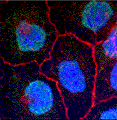Biochemistry, Department of
Document Type
Article
Date of this Version
1991
Abstract
Using a cotransformation system to identify chloroplast transformants in Chlamydomonas reinhardtii, we converted histidine-195 of the photosystem H reaction center D1 protein to a tyrosine residue. The mutants were characterized by a reduced quantum efficiency for photosynthetic oxygen evolution, which varied in a pH-dependent manner, a reduced capacity to oxidize artificial donors to photosystem II, and P680+) reduction kinetics (microsecond) that were essentially similar to wild type. In addition, a dark-stable radical was detected by ESR in mutant photosystem II particles but not in wild-type particles. This radical was similar in g value and lineshape to chlorophyll or carotenoid cations but could have arisen from a tyrosine-195 cation. The ability of the photosystem II trap (P680+) to oxidize tyrosine residues suggests that the mutant tyrosine residue could be used as a redox-sensitive probe to investigate the environment around the photosystem II trap.



Comments
Published in Proc. Nadl. Acad. Sci. USA Vol. 88, pp. 9122-9126, October 1991. Used by Permission.